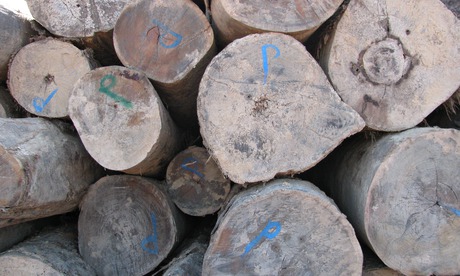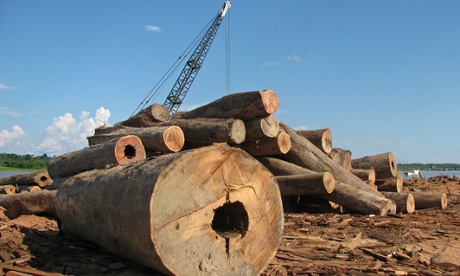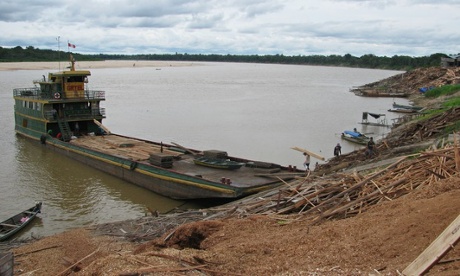Illegal loggers remain hidden in Peru’s forest but timber finds global buyers
State exercises little control over remote Amazon region blighted by poverty and illiteracy, and organised crime fills the vacuum

Javier Gomez sucks the last morsels of meat from the leg bone of anagouti, a large Amazonian rodent, his creased face belying his 44 years. ‘We’re just happy to have the work,” he shrugs wearily. “Here the only work is timber, that’s it. It’s heavy work but we’re used to it.” Older than his sinewy companions, Gomez says he will earn around $825 for spending four months logging in a camp two days up the Mayuruna river from his home village.
In this remote part of Peru’s 700,000 sq km of Amazon rainforest, there is not much beyond subsistence fishing and farming as a way to earn a living. Other options are mostly illegal: logging Amazonian hardwoods, growing coca, hunting and selling bushmeat. These activities are all prohibited, but in Loreto, an Amazon region larger than Germany, the state is virtually absent. Levels of poverty and illiteracy are far above the national average. Organised crime and evangelical sects fill the vacuum. As in the Rudyard Kipling poem, here the “law of the jungle” is “as old and as true as the sky”.
The murder of forest campaigner Edwin Chota with three fellowAshaninka leaders – Jorge Rios, Leonicio Quintisima and Francisco Piñedo – at the beginning of last month briefly drew the world’s attention to Peru’s rainforest. The remains of just three men, shot dead in the forest, have been found. DNA profiling using relatives’ hair samples are being used to identify the bodies. The authorities arrested the alleged killers, illegal loggers Adeuzo and Eurico Mapes, a father-and-son pair who are reported to have threatened Chota when he informed officials of their activities. These complaints fell on deaf ears, say members of his community, Alto-Tamaya Saweto.
“The threats began many years ago, ever since we started to report the illegal loggers’ activities,” Egilia Rengifo, the widow of leader Rios, said.
“The regional government is in collusion with the lumber businesses and timber concessionaries so we are not surprised that we were ignored,” she said, speaking her native Ashaninka language. She is still fearful. “We know that the murderers were paid by powerful businessmen,” she said in a clear voice, her grief now mixed with anger. “We’re asking the state to protect our lives.”
Peru’s forestry inspection service, OSINFOR, shut down four concessions belonging to Carlos Henderson, the vice-president of the same region, Ucayali, when he could not explain the origin of 4,000 cubic metres of timber.

But cases like this are the exception, says Julia Urrunaga, Peru director for the Environmental Investigations Agency. The laundering of timber detailed in the organisation’s 2012 report begins with forestry engineers who hand out fake forestry inventories, she says, but even when it is discovered that they have committed fraud and their names are posted online, nothing happens.
“We don’t understand why these people have not been investigated, we’ve been given all sorts of bureaucratic responses,” she remarks, exasperated.
Peru’s Amazon tri-border with Colombia and Brazil seems impossibly distant from the sluggish government agencies and well-intentioned NGOs in the capital, Lima. This is frontier territory where backwater bureaucrats rubber-stamp passing timber shipments and don’t make a fuss. No one misses their post-lunch siesta.
One official in Pebas, a large town on the Amazon river, explained that they didn’t have the logistics to do the job. Sitting beside a rusting typewriter, he said he didn’t even have the budget to buy diesel for a boat trip. Clearly resigned to the situation, it later transpired that he had not even left his office to check the paperwork of a barge carrying more than 600 cubic metres of cut timber.
“Everyone gets bribed. The police know this and the wood passes through,” admits Felipe Portocarrero, a powerfully built timber merchant sitting shirtless on a deckchair at a sawmill on the Yavari river, which marks the border between Peru and Brazil.
“Here the businessmen like to give money to the illegal loggers because the wood is cheaper. There’s plenty of them,” he adds with a wry smile. Three-quarters of the passing timber is illegal, he calculates, plundered from indigenous reserves and protected national parks. Many of the evocative local names for the trees such as cumala, lupuna, shihuahuaco and ishpingo get discarded along with the wood chippings. Even the type of wood gets whitewashed on its way to the US, Europeand, increasingly, China, which buys more than 40% of Peru’s timber.

Amid the buzz of table saws, Portocarrero gestures nonchalantly down a small mountain of castoff wood to a river barge being steadily loaded with freshly cut planks. Within a few days it would be full to its 300-tonne capacity and would ply its way back upriver into Peru, just like a dozen other barges loading up at sawmills on this bend in the river. The sheer amount of wood was staggering.
“Of course, there’s corruption,” admits the regional head of customs and tax inspection, Jorge Romano, not hiding his frustration. “Consider the immensity the Amazon basin versus the existing points of control, you have seen that they’re extremely limited.”
Getting the paperwork is easy, explains William Arellano, one of the 12 forestry inspectors in Peru’s vast, virtually roadless northern Amazon region of Loreto.
“We can’t calculate the quantity of illegal wood. It arrives with the paperwork but we know that mafias sell the documents needed to verify the wood’s origin and volume,” he says. It is his job to check that the trees earmarked for harvest – down to their GPS-coordinates – in logging concession forestry plans are what actually get felled, and not trees from elsewhere.
Traceability could be resolved using a DNA tracking system, says Denis del Castillo of the Peruvian Amazon Research Institute. Technology could permit trees to be traced back to the place of origin, making fraud almost impossible.
Given the vast distances and inaccessibility of much of the territory, not to mention the cost of technology, it seems a pipe dream. But British businessman Gareth Hughes is swimming against the tide in this region, trying “to prove that private investment and business could be sustainable in the tropics, in this case Peru”.
Hughes runs Green Gold Forestry, the only Forest Stewardship Councilcertified company in Peru. “It’s been very difficult, very much pushing a rock up a hill,” says the Welshman, but he’s confident that markets are developing for sustainably logged timber.
“It’s going to be a market-driven process but we think that the future is very bright.”
How long it will be before Peru’s Ashaninka people can protect their forests without fear, and workers such as Javier Gomez can reap the benefits, of that bright future is still uncertain.
• This article has been amended to clarify that the area of Peruvian Amazon in question is the Loreto region.

No comments:
Post a Comment
Comments always welcome!